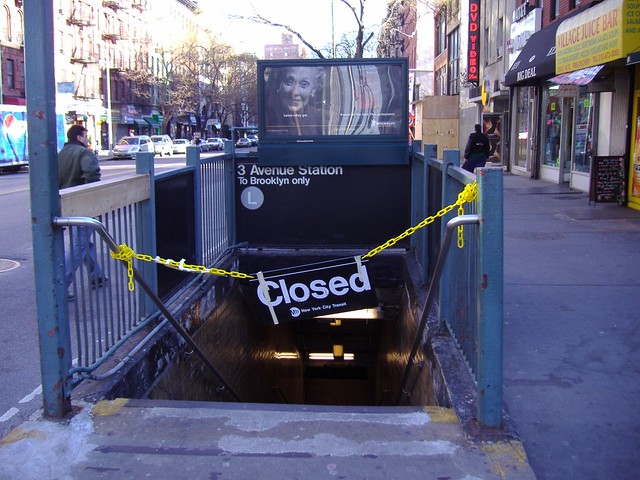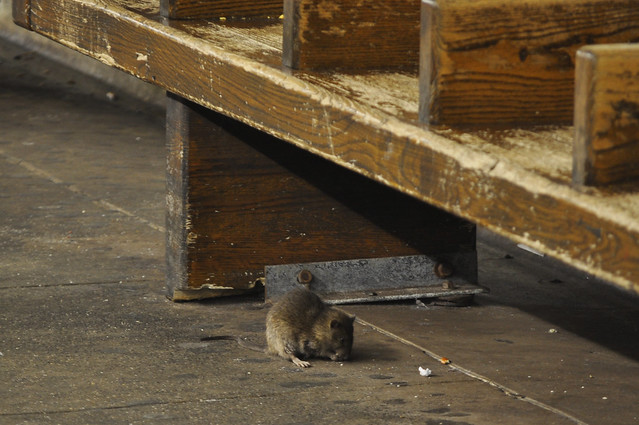
During the 2005 transit strike, the MTA had to chain off the entire subway system. (Photo by flickr user h-bomb)
It’s now been 15 days the TWU’s current contract with the MTA expired. In the intervening two weeks, the two sides have gone through the public spectacle of negotiations with one side — the TWU — walking away for a few days in dramatic fashion and the other leaking some demands. As John Samuelsen and Joe Lhota work to find a resolution, the union president says he won’t rule out a strike, but a peaceful resolution is the more likely path toward a new labor pact.
For New Yorkers, even the talk of a transit strike is enough to send us back to those cold three days in 2005 when the subways did not run. Just over six years ago, the TWU, defying the law, did indeed strike, and New Yorkers were left without subway service as Christmas neared. As I was for New York’s defining moments of the first decade of the 21st Century, I missed the transit strike. I was in D.C. that week, not due back in New York for a few more days, and by the time I returned to the city, the strike was over. Today, I want to revisis that strike.
Those days in December were heady times for the MTA and the TWU. Concerned with out-year budget projections of steep deficits, the MTA wanted to cut labor costs. In order to restrain pension spending, the authority proposed pension cuts and called upon the TWU to allow conductors to walk through train cars. It was viewed by many as another step along the path toward conductorless cars, and the union balked.
The city began to prepare for a costly strike as negotiations dragged on, and even though the TWU rank and file authorized a strike, analysts were skeptical. Such a strike would, many said, be in violation of the Taylor Law, and the leadership would be risking a lot by leading a strike. The city, meanwhile, was preparing to throw the book at anyone who struck illegally.
As business owners tried to arrange alternate transportation for their workers, the MTA continued to enjoy a December of cut rates. That winter, you may recall, the authority used an end-of-year surplus to offer $1 rides for all pay-per-ride straphangers. It all came to head on December 20, though, as union leadership decided to strike after failing to reach an agreement with the MTA.
With temperatures in the upper 20s, straphangers had to battle the elements and massive crowds as cab share plans were initiated and car trips into Manhattan were carefully limited. A state judge levied massive fines against the TWU as an organization and against its leadership personally for the strike. The Times called it an “unnecessary strike.”
On Day Two of the strike, New Yorkers grew weary. Traffic marred the streets while many simply worked from home. It was a cold winter day for tourists, shoppers, business people and families who could not escape the confines of their neighborhood, and Judge Theodore T. Jones threatened then-TWU President Roger Toussaint with jail time over the strike. On the third day, after 60 excruciating hours, the strike ended. State mediators had convinced the two sides to work toward a deal, and the MTA seemed willing to grant generous raises while dropping demands to raise the retirement age from 55 to 62. The TWU seemed willing to take an increase in pension contributions as well.
Across the city, businesses bemoaned the losses with lost revenue estimated at half a billion dollars. Roger Toussaint faced a short jail sentence, and the union lost its ability for automatic dues check-offs. Eventually, leadership agreed not to authority illegal strikes in exchange for the restoration of that right, but it took the TWU a few years to recover from that strike.
Today, as the MTA is demanding a net-zero labor increase, and the union wants some small raise in its contract, the two sides are at different places than they were six years ago. The union seemingly recognizes the MTA’s financial situation, and the MTA will hold a firm line while keeping dialogue moving forward. The last strike was a reminder of how reliant the city is on its subway system, and while, with no deal in place, the vague threat hovers above the negotiations, I doubt we’ll see a repeat of 2005 any time soon.

